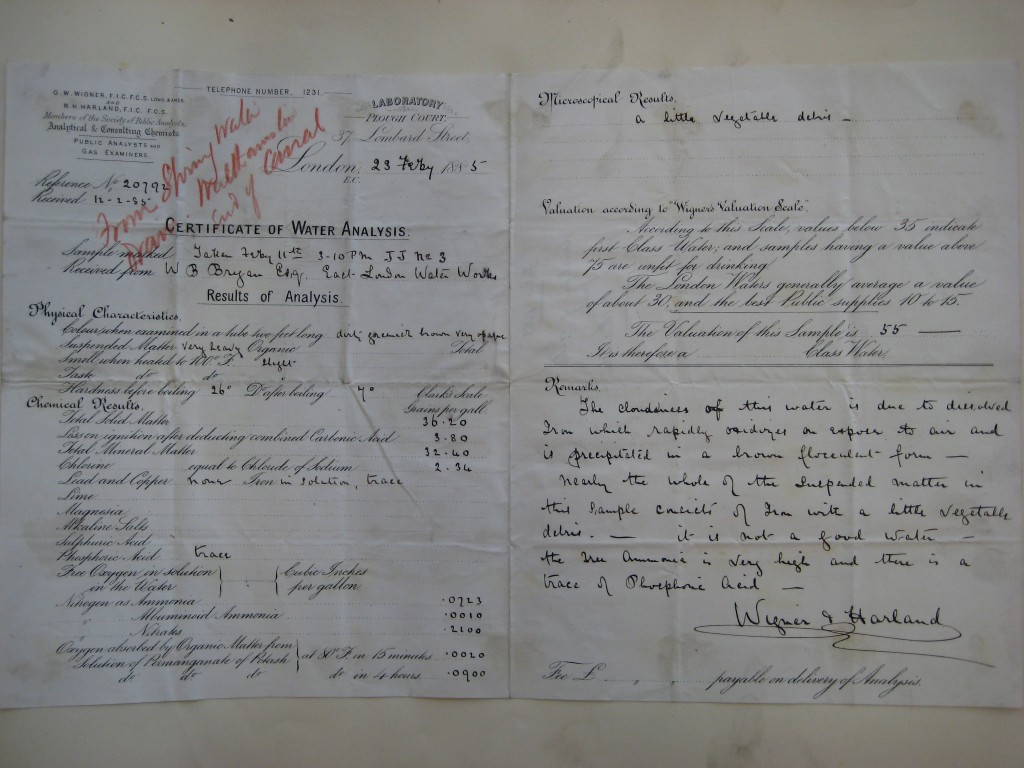8 November 2011
Thames River contamination tied to World War II gardens
Posted by kramsayer

Nicholas Howden and his colleagues looked at 140 years worth of water quality measurements, including this entry from 1885, to track nitrogen in the Thames River basin. (Credit: Nicholas Howden)
A World War II “Dig for Victory!” campaign, while the United Kingdom was effectively cut off from Canadian food supplies, played a key role in today’s nitrogen contamination of the Thames basin. That’s according to researchers who dug into century-old, leather-bound volumes of water quality measurements dating back to the mid-1800s.
Nicholas Howden, of the University of Bristol in the United Kingdom, and his colleagues have pieced together a story of nitrogen in Britain’s Thames River watershed that stretches back 140 years. While fertilizers might get a lot of the attention when talk turns to nitrates polluting aquifers and rivers, Howden’s team found that World War II-era land use decisions have also played a key role in the Thames basin.
Desperate to feed themselves while under attack by Germany, the British “plowed up every piece of land they could find to grow food,” Howden says. “A lot of this land had been lying as permanent grassland for decades, building up supplies of nitrogen. Once plowed, [the soil’s nitrogen] was then released.”
“These are systems that work on multi-decadal timescales, and we have to think of them in a different way,” says Howden, whose research will be published Nov. 12 Water Resources Research, a journal of the American Geophysical Union.
Howden and his team developed a computer model that simulates how nitrogen moves through the Thames watershed. The earliest information stems from the 1850s. Around that time, cholera outbreaks in London and the “great stink” – when raw sewage in the Thames and sweltering summer weather combined to create a foul stench through the city – led to dedicated water quality monitoring. And that included monthly measurements of nitrate concentrations from Hampton, just upstream of London.
“It’s taken me about three years to find them all,” Howden says. While the main archives were in London and Oxford, he had to track down missing records to other collections in California at Stanford University.
Excess nitrogen in drinking water, in the form of nitrates that can stem from fertilizers or natural sources, can cause illnesses in infants, according to the Environmental Protection Agency. And high nitrate concentrations in waterways can also upset ecosystem balances, leading to algae blooms that, when they die off, deplete the waterways of oxygen.
Looking at nitrogen in the Thames, the researchers developed a model incorporating the water quality data from 1868, land use records, and nitrogen inputs from other sources, including livestock and fertilizer. And they found that while fertilizer contributes about 40 percent of the nitrogen load in the Thames catchment, plowing grasslands into farmland led to a large nitrogen contribution to the watershed as well.
“These are systems that work on multi-decadal timescales, and we have to think of them in a different way” than contaminants which pass quickly through the environment , says Howden.
After the WWII-era agriculture spike, nitrogen has been accumulating in the basin at a rate of about 100,000 tons a year, the researchers found – but the basin ecosystem can only remove about 35,000 tons of nitrogen through natural processes. It takes about 30 years for nitrogen to work its way through the Thames catchment, Howden says. So the contamination will stick around for decades, even if action is taken now to reduce already-problematic nitrogen amounts in the water supply.
“In parts of the UK, the water companies are having to switch off sources because the concentrations are just too high,” Howden says.
![]() Howden, N., Burt, T., Worrall, F., Mathias, S., & Whelan, M. (2011). Nitrate pollution in intensively farmed regions: what are the prospects for sustaining high-quality groundwater? Water Resources Research DOI: 10.1029/2011WR010843
Howden, N., Burt, T., Worrall, F., Mathias, S., & Whelan, M. (2011). Nitrate pollution in intensively farmed regions: what are the prospects for sustaining high-quality groundwater? Water Resources Research DOI: 10.1029/2011WR010843
– Kate Ramsayer, AGU science writer



 GeoSpace is a blog on Earth and space science, managed by AGU’s Public Information staff. The blog features posts by AGU writers and guest contributors on all sorts of relevant science topics, but with a focus on new research and geo and space sciences-related stories that are currently in the news.
GeoSpace is a blog on Earth and space science, managed by AGU’s Public Information staff. The blog features posts by AGU writers and guest contributors on all sorts of relevant science topics, but with a focus on new research and geo and space sciences-related stories that are currently in the news.
[…] cool. Thames River contamination tied to World War II gardens. https://blogs.agu.org/geospace/2011/11/08/thames-river/ (via […]